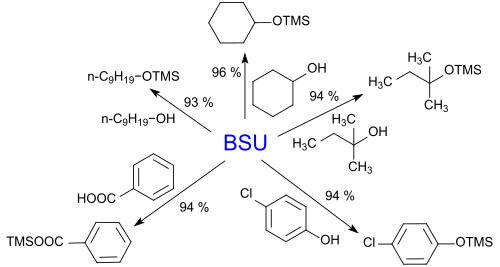N , N '-bis (trimethylsilyl) urea
| Structural formula | ||||||||||||||||
|---|---|---|---|---|---|---|---|---|---|---|---|---|---|---|---|---|

|
||||||||||||||||
| General | ||||||||||||||||
| Surname | N , N '-bis (trimethylsilyl) urea | |||||||||||||||
| other names |
BSU |
|||||||||||||||
| Molecular formula | C 7 H 20 N 2 OSi 2 | |||||||||||||||
| Brief description |
colorless crystalline solid or colorless crystal needles. |
|||||||||||||||
| External identifiers / databases | ||||||||||||||||
|
||||||||||||||||
| properties | ||||||||||||||||
| Molar mass | 204.42 g mol −1 | |||||||||||||||
| Physical state |
firmly |
|||||||||||||||
| Melting point | ||||||||||||||||
| solubility |
readily soluble in methanol , ethanol and diethyl ether , soluble in dichloromethane and dimethyl sulfoxide , in diethyl ether and acetone , reacts with water |
|||||||||||||||
| safety instructions | ||||||||||||||||
|
||||||||||||||||
| As far as possible and customary, SI units are used. Unless otherwise noted, the data given apply to standard conditions . | ||||||||||||||||
N , N ′ -Bis (trimethylsilyl) urea BSU is a urea derivative in which one hydrogen atom on both amino groups has been replaced by a trimethylsilyl group (TMS protective group). BSU is advantageously used as a silylation reagent for alcohols and carboxylic acids , since it does not require acid or base catalysis and the by-product urea in non-polar solvents, such as. B. dichloromethane CH 2 Cl 2 is practically insoluble.
Manufacturing
The synthesis of N, N′-bis (trimethylsilyl) urea was first reported in 1963 by Ulrich Wannagat's group .
BSU is produced in 98% crude yield when urea is heated with excess hexamethyldisilazane HMDS. However, the product is contaminated with traces of trimethylsilyl isocyanate Me 3 SiNCO, HMDS, and hexamethyldisiloxane Me 3 SiOSiMe 3 and is of little use as a silylating reagent even after sublimation .
The reaction of urea with hexamethyldisilazane in the presence of (volatile) acidic catalysts, such as B. ammonium chloride , acetic acid or hydrogen chloride , provides pure yields over 98% with silylation activities around 100% even in industrial reaction approaches.
properties
N , N ′ -Bis (trimethylsilyl) urea is a colorless, crystalline solid that dissolves in many organic solvents and reacts with water to form urea and hexamethyldisiloxane. The substance should therefore be stored with the exclusion of moisture and in an inert atmosphere. The strongly fluctuating values of the stated melting points are due to impurities in the product, which are also reflected in reduced silylation activities. Vacuum sublimation of contaminated products yields only a somewhat purer product with considerable losses.
Applications
Silylation is an equilibrium reaction in which an active hydrogen atom H on a heteroatom X is replaced by a trimethylsilyl radical TMS.
The removal of the resulting HY molecule (urea in the case of BSU, ammonia NH 3 in the case of HMDS) is decisive for a high product yield. Silylating agents, e.g. B. chlorotrimethylsilane TMS-Cl or trimethylsilyl trifluoromethanesulfonate TMSOTf, which can be regarded as esters of strong acids, require the use of bases such as triethylamine or pyridine to trap the acids formed during the reaction. In contrast, silazane- like reagents such as BSU are weak bases and react under mild conditions with primary, secondary and tertiary alcohols , phenols and carboxylic acids . As a rule, product yields of over 90% are achieved.
A special case of the silylation of hydroxyl groups is the reaction of N , N ′ -bis (trimethylsilyl) urea with carbamide peroxide (solid hydrogen peroxide) to form bis (trimethylsilyl) peroxide , an anhydrous, protected hydrogen peroxide .
The reaction takes place in dichloromethane, in which the resulting urea precipitates. The liquid product (86% yield) is isolated by distillation.
Dipolar aprotic solvents, such as acetonitrile , dimethylformamide or pyridine , which also contain polyhydroxy compounds, e.g. B. glucose or glucosides such as methyl-α-D-glucopyranoside are soluble, promote the silylation reaction, the added in small amounts of the silyl cleavage reagent tetrabutylammonium fluoride TBAF should act as an initiator.
To increase the reactivity, combinations of silylating agents are often used, such as. B. Hexamethyldisilazane + trimethylchlorosilane. Alternatively, highly reactive silyl reagents such as TMSOTf or trimethylsilylfluorosulfonate TMSOFs can also be generated in situ from the superacids trifluoromethanesulfonic acid or fluorosulfonic acid in catalytic amounts.
Very high product yields are made possible by using the inexpensive N , N ' -bis (trimethylsilyl) urea instead of the expensive triflates or fluorosulfonates. With TMSOFs generated in situ, practically quantitative yields can be achieved in the reduction of benzaldehyde dimethylacetal using triethylsilane
or the formation of the ketalization of 4-methylcyclohexanone with 1,2-bis (trimethylsilyloxy) ethane (silylated ethylene glycol ).
With BSU, primary amines provide the corresponding N -trimethylsilylamines, which react with styrene oxide to give 1-phenylethanolamines in good yields (64–84%).
In terms of quantity, the most important application of N , N ′ -bis (trimethylsilyl) urea in the past was in the silylation steps in the multi-stage chemical conversions of penicillin G with ring expansion from the five-membered penam ring to a six-membered cephem ring to form cephalosporin G and in the subsequent acylation of the parent compounds 7-aminodesacetoxycephalosporanic acid (7-ADCA) or 7-aminocephalosporanic acid (7-ACA) (from cephalosporin C) to form semi-synthetic cephalosporins. Although the optimization of industrial chemical processes increases the yield on the first stage from penicillin G to penicillin G sulfoxide up to 92.4% with a purity of> 98.3% and on the second stage from penicillin G sulfoxide to cephalosporin G up to 94% with a purity of> 98%, more efficient and, in particular, more environmentally friendly enzymatic processes have made these BSU applications largely obsolete.
literature
- Silylating Agents. (PDF; 716 KB) In: sigmaaldrich.com. Fluka Chemie AG, accessed on July 20, 2018 (English).
Individual evidence
- ↑ a b Data sheet N, N'-bis- (trimethylsilyl) -urea from Sigma-Aldrich , accessed on July 21, 2018 ( PDF ).
- ↑ a b c U. Wannagat, H. Bürger, C. Krüger, J. Pump: Contributions to the chemistry of silicon-nitrogen compounds. XII Some silicon-urea compounds . In: Z. Anorg. General Chem. Band 321 , no. 3-4 , 1963, pp. 208-216 , doi : 10.1002 / zaac.19633210313 .
- ↑ a b c Data sheet N, N'-Bis (trimethylsilyl) urea from AlfaAesar, accessed on July 21, 2018 ( PDF )(JavaScript required) .
- ↑ a b c J. Wisniewski Grissom: N, N'-Bis (trimethylsilyl) urea . In: e-EROS Encyclopedia of Reagents for Organic Synthesis . 2001, doi : 10.1002 / 047084289X.rb223 .
- ^ Daniel R. Knapp: Handbook of Analytical Derivatization Reactions . John Wiley & Sons, New York, NY, USA 1979, ISBN 0-471-03469-X , pp. 35 .
- ^ A b W. Verboom, GW Visser, DN Reinhoudt: N, N'-Bis [trimethylsilyl] -urea: A useful silylating agent for alcohols and carboxylic acids . In: Synthesis . tape 10 , 1981, pp. 807-809 , doi : 10.1055 / s-1981-29605 .
- ↑ a b c Patent DE2553932A1 : Process for the production of N, N'-bis-trimethylsilylurea. Filed December 1, 1975 , published June 2, 1977 , applicant: Dynamit Nobel AG, inventor: H.-J. Kötzsch, H.-J. Vahlensieck.
- ↑ a b M.T. El Gihani, H. Heaney: The use of bis [trimethylsilyl] acetamide and bis [trimethylsilyl] urea for protection and as control reagents in synthesis . In: Synthesis . tape 4 , 1998, pp. 357-375 , doi : 10.1055 / s-1998-2043 .
- ↑ WP Jackson: A simple preparation of bis (trimethylsilyl) peroxide . In: Synlett . tape 9 , 1990, pp. 536-536 , doi : 10.1055 / s-1990-21157 .
- ^ DA Johnson: Simple procedure for the preparation of trimethylsilyl ethers of carbohydrates and alcohols . In: Carbohyd. Res. Band 237 , 1992, pp. 313-318 , doi : 10.1016 / S0008-6215 (92) 84254-P .
- ^ Y. Tanabe, M. Murakami, K. Kitaichi, Y. Yoshida: Mild, effective and selective method for the silylation of alcohols using silazanes promoted by catalytic tetrabutylammonium fluoride . In: Tetrahedron Lett. tape 35 , no. 45 , 1994, pp. 8409-8412 , doi : 10.1016 / S0040-4039 (00) 74419-4 .
- ↑ M. El Gihani, H. Heaney: The use of bis-trimethylsilyl-acetamide and -urea in trimethylsilyl trifluoromethanesulfonate catalysed reactions . In: Synlett . tape 6 , 1993, pp. 433-434 , doi : 10.1055 / s-1993-22485 .
- ↑ M. El Gihani, H. Heaney: A convenient alternative route to trimethylsilylfluorosulfonate for use in catalytic reactions . In: Synlett . tape 8 , 1993, pp. 583-584 , doi : 10.1055 / s-1993-22538 .
- ^ RK Atkins, J. Frazier, LL Moore, LO Weigel: Alkylation of N-trimethylsilylated primary amines with arylethylene oxides. An efficient synthesis of 1-phenethanolamines . In: Tetrahedron Lett. tape 27 , no. 22 , 1986, pp. 2451-2454 , doi : 10.1016 / S0040-4039 (00) 84553-0 .
- ↑ Alle Bruggink (Ed.): Synthesis of β-Lactam Antibiotics: Chemistry, Biocatalysis & Process Integration . Springer Science + Business Media, Dordrecht 2001, ISBN 978-94-010-3851-5 , p. 15 .
- ↑ P. Salehpour, R. Yegani, R. Hajmohammadi: Determination of optimal operational conditions for production of cephalosporin G from penicillin G potassium . In: Org. Process Res. Dev. Band 16 , no. 9 , 2012, p. 1507-1512 , doi : 10.1021 / op300076q .








